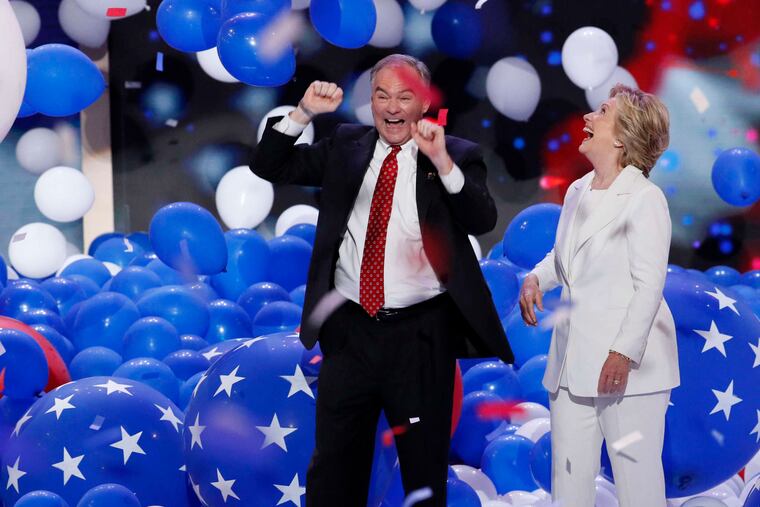Commentary: For students, a hands-on view of politics and journalism
By Patrick J. Morgan and Pedro A. Ramos There's great post-convention buzz in the city right now. But what did one important audience - the next generation of voters - see and experience? What were they thinking as they witnessed this unusual presidential election year?

By Patrick J. Morgan
and Pedro A. Ramos
There's great post-convention buzz in the city right now. But what did one important audience - the next generation of voters - see and experience? What were they thinking as they witnessed this unusual presidential election year?
Providing young people with a voice is essential to building a strong democracy into the future. It is also important in creating a culture of civic engagement in Philadelphia and building a community of problem-solvers who are committed to shaping their city.
That's why the Knight and Philadelphia Foundations supported the Youth News Team - an idea proposed by the DNC Host Committee and the Rendell Center for Civics and Civic Engagement. We funded the team through a grant to WHYY, which gave 25 student volunteers the chance to witness the convention as reporters.
The five teams - each with five members - were composed of students from Philadelphia high schools and middle schools. Their task? Cover the convention and contribute young voices to the conversation. They were mentored by reporters and editors from WHYY, KYW, and PSTV, the School District of Philadelphia's education channel.
We and our partners see journalism as one key to a strong Philadelphia community. Few civic challenges can be faced without a healthy flow of news and information, and we believe in engaging youth in the process.
Shayna Allie, a 17-year-old rising senior at Girls' High, said her first day as a reporter landed her at the Pennsylvania Convention Center with a video team. Her assignment: to roam and talk to passersby about the hot-button issue of immigration. Not easy for a teenager - or anyone, for that matter.
As she looked around for an interview subject, Shayna decided to approach an interesting woman who did not look like many of the other convention types she was seeing. What started as an uncomfortable experience turned into an intriguing one, and Shayna lost her nervousness as a first-time reporter.
Serendipitously, the woman she picked to interview was an undocumented immigrant. She talked about her life in the shadows, the obstacles she and her family faced, and the fear of being deported. That day, Shayna realized people do want to tell their stories; they want to see if others can relate, or they want to share their challenges or accomplishments. That experience showed Shayna that news was all around her in Philadelphia. And that one story helped her to better understand what it's like to be an immigrant in America. She recognized the need to share that experience with others as a journalist.
Engaging our youngest generation in the news opens their eyes to the world around them. And the rest of us benefit from seeing the world through those eyes. At the same time, it's becoming increasingly essential to connect young people, the leaders of tomorrow, with issues that affect their lives, so that they can become active, engaged members of the community.
In their applications for this program, when asked what type of stories interested them most, students demonstrated that they already were attuned to key national topics, speaking of the challenges associated with mass incarceration, immigration policies, and racial inequality. The initiative simply gave students the training and resources to dig in and enlighten us all with their findings, while providing them with a megaphone to get involved.
When the student reporters were being trained in "boot camp," they were taught to never shy away from asking "why" about anything they saw, regardless of the power of the individuals, political groups, and news organizations involved. And their journalist mentors told them that they were free to pursue whatever stories they thought needed to be told. This was a workshop on civics education, not just journalistic techniques.
William Hite, superintendent of the School District of Philadelphia, remarked that this was a tremendous opportunity to witness history. Students not only learned about the inner workings of journalism and presidential campaigns, they saw the importance of civic engagement and our democratic process.
We couldn't agree more. The students got a unique view into politics and covering it - a view that will forever inform them as citizens - and the rest of us learned from their stories, which will be shown in the weeks ahead on the school district's PSTV and through additional media partners. And the Youth News Team will continue to use the skills they acquired to report on topics through Election Day.
The gathering and presentation of news will continue to change in ways we can't anticipate. Today's students will need to adapt to and help shape those changes. We believe that what our young journalists learned during the DNC as reporters will start them on that path.
The students' experiences highlight the importance of creating a new generation of engaged citizens, while emphasizing the essential role of journalism in advancing an inclusive civic dialogue. That's what creating a strong democracy is all about.
Patrick J. Morgan is the Philadelphia-based program director of the John S. and James L. Knight Foundation. morgan@knightfoundation.org
Pedro A. Ramos is president and CEO of the Philadelphia Foundation. president@philafound.org